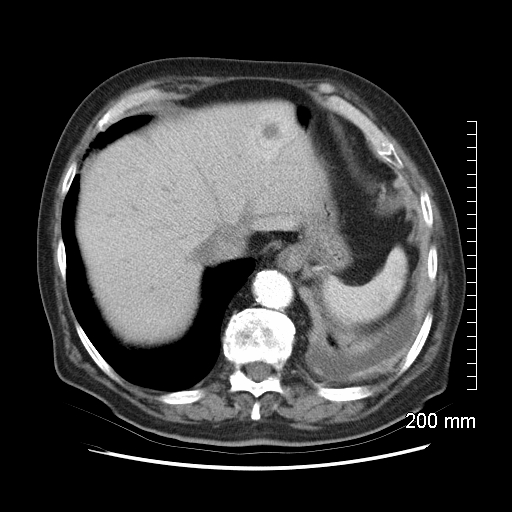History: 67 yo male with increasing shortness of breath
Solution: Mesothelioma
These images show a fairly typical appearance for malignant mesothelioma with extensive lobulated masses involving much of the pleural surface. There is also a small associated effusion, calcified pleural plaquing and a metastatic focus in the liver.
There are both benign and malignant forms of mesothelioma. The benign form is more frequently called a fibrous tumor of the pleura and is often asymptomatic, solitary, and usually not associated with asbestos exposure.
Malignant mesothelioma is an uncommon neoplasm of the serosal lining of the thorax or abdomen. It is the most common primary neoplasm of the pleura, but is still relatively uncommon, with only 2-3,000 new cases per year in the US. Approximately 1 in 10 people who have had significant asbestos exposure will develop pleural malignant mesothelioma, but only approximately half to three quarters of patients will have a history of significant asbestos exposure. The relationship of peritoneal mesothelioma to asbestos exposure is less clear. The latency period between exposure and development of the disease is often quite prolonged, up to 40 years or more and at least 20 years. About half of patients will have calcified pleural plaques indicative of asbestos exposure. The prognosis is dismal with a mean survival of less than a year after diagnosis. Interestingly, this patient subsequently developed inguinal pain and swelling and was found to have a drop metastasis into the right inguinal canal with associated ascites and peritoneal spread.




These images show a fairly typical appearance for malignant mesothelioma with extensive lobulated masses involving much of the pleural surface. There is also a small associated effusion, calcified pleural plaquing and a metastatic focus in the liver.
There are both benign and malignant forms of mesothelioma. The benign form is more frequently called a fibrous tumor of the pleura and is often asymptomatic, solitary, and usually not associated with asbestos exposure.
Malignant mesothelioma is an uncommon neoplasm of the serosal lining of the thorax or abdomen. It is the most common primary neoplasm of the pleura, but is still relatively uncommon, with only 2-3,000 new cases per year in the US. Approximately 1 in 10 people who have had significant asbestos exposure will develop pleural malignant mesothelioma, but only approximately half to three quarters of patients will have a history of significant asbestos exposure. The relationship of peritoneal mesothelioma to asbestos exposure is less clear. The latency period between exposure and development of the disease is often quite prolonged, up to 40 years or more and at least 20 years. About half of patients will have calcified pleural plaques indicative of asbestos exposure. The prognosis is dismal with a mean survival of less than a year after diagnosis. Interestingly, this patient subsequently developed inguinal pain and swelling and was found to have a drop metastasis into the right inguinal canal with associated ascites and peritoneal spread.








